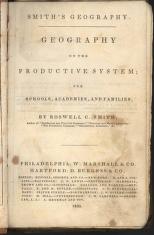|

"A System of School Geography"

"Smith's Geography on the Productive System; for Schools, Academies, and Families"
|
Summary and Objective
Students will understand that the words "civilization" and "civilized" have been and can be co-opted by various groups throughout history to further their own aims. In other words, students will understand that these definitions have changed throughout history and are open to multiple interpretations.
Teaching Plan
Step 1.
Brainstorm, together with your students, what is means to be civilized or to live in a civilization. Provide students with a working definition for the word: civilization. For example, "A Civilization is a society that has cities, a central government run by official leaders, and workers who specialize in various jobs. Writing art, and architecture also characterize a civilization (from Prentice Hall: World Studies The Ancient World)". I further reinforce this concept by providing my students with class notes outlining the various characteristics that most civilizations have. Please see my website link below for sample notes. Later in the lesson, students will be encouraged to challenge aspects of this definition.
Step 2.
Then use an already familiar example, I usually choose Ancient Egypt as my students generally have covered this area of the world in elementary school and we will be covering it again later in the year, to see if it qualifies for civilization status under this definition. For example, does Egypt have unique architecture? (yes, the pyramids); Does Egypt have social classes? (yes, the Pharaoh, priests and nobles, merchants and artisans, peasant and laborers); etc.
Step 3.
Next ask students if the people living in a civilization are civilized. Probe the class to see if there is a consensus on what it means to be "civilized", "uncivilized" or even a "barbarian".
Step 4.
Provide students with some examples of how these words came into our lexicon. For example, the word "barbarian" derives from the Greek word "barbaroi" meaning foreign or not like us. Some etymological dictionaries further trace this word back to the Greeks misunderstanding foreign languages, i.e to them Persian might sound like "bar, bar" or nonsense words to them. Ask students if being considered "foreign" or "different" is a good or bad thing and if it might vary from situation to situation.
Step 5.
Next show the students the book plates from the American Centuries Website. Using "Think, Pair, Share" ask your students the following questions: How are the Native people depicted? Would you like to be drawn this way? In what ways are the British settlers trying to differentiate themselves from the American Indians? How do these images mesh with our class definition of a civilization? How has the concept of a civilization changed from the ancient world to today? Why do we need to be careful when we use words like "civilization", "civilized", and "barbarian"?
Step 6.
Facilitate a full group discussion about the meanings of these three words. Ask students to share their partner answers from step five. Finally, ask students to recall our working definition of a civilization from Step #1. Ask the class whether of not they think this definition is comprehensive enough? Or do they believe it is perhaps too narrow thereby excluding certain cultures who, for example, did not build cities and/or permanent structures?
Step 7.
If applicable, make a connection between the class definition of a civilization and the region of the world that you are currently studying, i.e. Mesopotamia in my case.
Step 8.
Lastly, ask students to use the other side of their "What Makes a Civilization" notes from step one, to visually show what it means to be a civilization. Students may also choose to show a civilization's characteristics through words/poetry. Please see attached student exemplars from my website.
|




